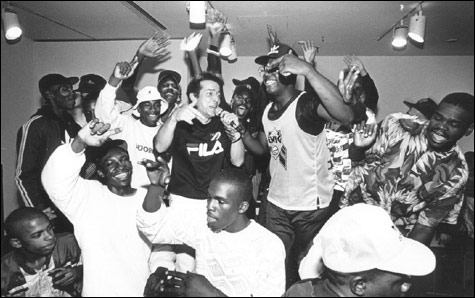
REPRESENT: Magnus Johnstone (the pale brother, center) debuted Boston radio's first all-rap program at MIT's WMBR in 1985.
|
Soon after music-minded UMass-Boston management professor Pacey Foster signed on to write a Boston chapter for the most comprehensive hip-hop tome ever compiled, his mission brought him to rural Maine, where it has long been speculated that the Hub rhyme scene's Holy Grail is safely stored.
Foster was seeking one elusive Magnus Johnstone, the legendary white hipster college disc jockey who debuted Boston's first all-rap program,
Lecco's Lemma, at MIT's student-run WMBR in 1985, and who has since relocated to the backwoods behind Bangor.
Access to artifacts was essential to the Bean's accurate portrayal in the 1094-page master narrative Hip-Hop in America: A Regional Guide (Greenwood Press), which drops this week following years of research by writers from across the country. (Its release will be celebrated by the Beat Research team Monday at Enormous Room.) Foster's elaborate Bay State account is anchored by his visit to Johnstone's Maine hideaway, where a treasure of cassettes and snapshots was tucked high above his stereo in wooden wine crates.
"It was classic Magnus," says the 42-year-old Foster, who had last seen his old friend in 1999. "He was playing music that I'd never heard before, and painting while we were talking, and the whole time I was dying to ask where the tapes were. Finally, after an hour and a half, he showed me the boxes, and the first thing I pulled out was a handwritten case from FTI (Fresh To Impress) Crew, which was Edo G's group back when he was called Edo Rock. I almost cried."
Foster felt a responsibility toward rap culture, and with that came the need to tap primary sources. He had tuned in religiously to Lecco's Lemma — and he remembers spending hours watching b-boys tear up Harvard Square — but as a white kid from Brookline, he says his direct involvement in hip-hop's heyday was limited to "lamely tagging on the Green Line."
So he studied Johnstone's fossils for traces of the past. Beneath the amateur demos were tales of Boston hip-hop in its infancy, and to fill in the blanks, he conducted interviews with Hub heroes like Lino Delgado of the Floorlords breaking crew, Cindy Diggs of Peace Boston, Rusty "the Toe Jammer" Pendleton of Funky Fresh Records, M.C. Spice, and Edo G. In time, with guidance from such early trend spotters as retail icon Skippy White, the amateur historian also mined the roots of Boston's rap establishment, which Foster links to local funk forefathers including pop producer Maurice Starr's brother Michael Jonzun and current Berklee music engineering prof "Prince" Charles Alexander.
Although Johnstone was just one unlikely player in a budding theater, his show served as Boston hip-hop's epicenter from 1985 to 1987, during which time he invited in and spun singles by the likes of Keithy E. (who would later be known as Guru of Gang Starr), Top Choice Clique, and Ray Dog and Emo E, who soon after found street rap prominence as Benzino and Twice Thou of Almighty R.S.O. By the late '80s, he was being turned off by what he perceived as hip-hop's devolution at the hands of major labels and suburban practitioners — yet his influence remains today. Since Boston didn't get a dedicated commercial rap outlet until JAM'N in 1993 (and because corporate stations mostly ignored local artists, as they do now), regional hip-hop survived solely on college frequencies, from Emerson to Salem State.